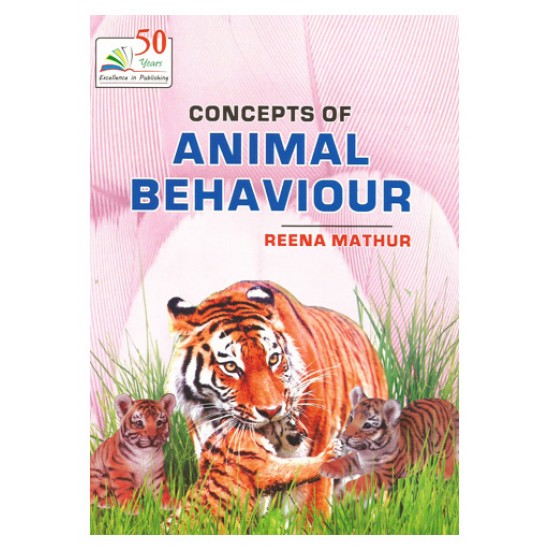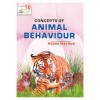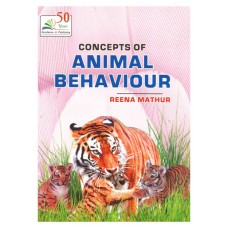CONCEPTS OF ANIMAL BEHAVIOUR
(An Abridged Edition)
(Based on undergraduate CBCS Syllabus)
(Based on undergraduate CBCS Syllabus)
INFO
- - Author: Reena Mathur
- - Product Code: Z-80
- - Availability: In Stock
Rs.225
CONTENTS:
1. Introduction and Significance of Study of Animal Behaviour: Introduction; Branches of Ethology; History; Significance of Study of Animal Behaviour; Animal Behaviour and the Environment; Animal Behaviour and Cell Biology; Animal Behaviour and Animal Welfare; Animal Behaviour and Science Education; Animal Behaviour and Human Society; Important Questions.
2. Concepts, Patterns and Mechanism of Behaviour: Introduction; Motivation; Fixed Action Patterns (FAP) or Instinctive Behaviour or Model Action Pattern (MAP); Characteristics of Instincts; Difference Between Instinctive and Learned Behaviour; Sign or Key Stimulus or Releasers; Innate Releasing Mechanism (IRM); Action Specific Energy (ASE); Physiological Basis; Learning or Experience; Imprinting; Behavioural Genetics; Evolution of Behaviour; Sociobiology; Aggressive Behaviour Patterns; Types and Causes of Aggression; Communication Patterns; Advantages of Communications; Types of Communication; Patterns of Parental Care; Types of Parental Care; Courtship Patterns; Important Questions.
3. Reflexes and Orientation: Introduction; Orientation; Kineses; Klinokinesis; Orthrokinesis; Taxes; Tropotaxis; Menotaxis, Klinotaxis, Mnemotaxis, Negative-positive Orientation; Positional Orientation; Object Orientation; Strato Orientation; Zonal Orientation; Topographic Orientation; Geographical Orientation; Echolocation; Language of Honey Bees.
4. Communication: Introduction; Types of Communication; Infrasound Communication Among Elephants and Whales; Ultrasound Communication by Sonar in Dolphins and Bats; Vocalization in Non-human Primates; Echolocation in Bats; 2. Visual Communication; 3. Chemical Signals; 4. Tactile Communication; Important Questions.
5. Social Organization, Mating Groups and Sexual Strategies: Introduction; Mating Groups; Advantages of Being Social; Social Organisation of Honey Bee; Life History; Hive; Social Groups of Deer, Antelopes and Monkeys; Important Questions.
6. Reproductive Behaviour, Sexual Conflict and Courtship: Introduction; Types of Fertilization; Sexual Conflict; Evolution of Courtship; Sequence and Synchronization; Characteristics of Courtship; Attention and Courtship; Brood Care and Courtship; Important Questions.
7. Learning and Neural Mechanism: Definition; Introduction; Types of Learning; Cognition, Reasoning and Insight; Studies on Crows and Ravens; Neural Mechanism of Learning.
8. Sociobiology: Definition; Introduction; Units of Sociobiology; Major Social Behaviours; Altruism; Hamilton's Theory; Food Sharing ; Confuse the Predator; Cooperation/Reciprocation; Selfishness; Eusociality; Important Questions.
9. Biological Clocks: Introduction; Circannual Clocks; Circatidal Clocks; Circalunar or Circasynodic Clocks; Semilunar or Circasyzygic Clocks; Circadian Clocks; Important Questions.
10. Experiments:
1. Photo Tactic Response in Earthworms / Grain or Pulse Pests.
2. Geotactic Response of Earthworm or Pest.
3. Communication in Earthworm by Pheromones.
4. Listing of all the Animals Found in and Around your House / Visit to a Zoo/Sanctuary/National Park.
5. Social Organization and Dominance in Rhesus (Macaca mulatta) and Langurs (Presbytis entellus).
6. Courtship in Ring Dove/Pigeons/Peacock.
7. Habituation to touch in Garden Snail.
8. Orientation in Pill Bugs.
9. Humidity and Light Preference in Sow Bugs.
10. Geotaxis in Snails/Slugs.
| Specifications | |
| Author | Dr. Reena Mathur |
| Edition | 1st Edition: 2018-2019 |
| Size | Crown 4vo |
| Pages | 264 |
| HINDI EDITION CODE No. | Z-54 |



